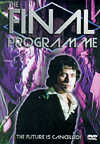Final Programme
Anchor Bay Entertainment
Cast: Jon Finch, Jenny Runacre, Hugh Griffith, Patrick Magee, Sterling Hayden
Extras: Commentary Track, Theatrical Trailer, U.S. TV Spot, Robert Fuest Bio
Rating:
Jon Finch (best remembered for Hitchcock’s "Frenzy") stars as Jerry Cornelius, a wayward son "mourning" the death of his famous biophysicist father. Set in an undetermined future, Jerry also happens upon even graver news: the world is coming to an end. Undaunted by recent developments, Jerry plans to have one final reckoning, namely blowing up the family mansion. A mysterious group of well-dressed scientists shadow Jerry, insisting that he turn over microfilm previously in his father’s possession and vital to the consortium’s "experiments." The scientific triad (one member is played by George Colouris of "Citizen Kane" fame) answer to the equally peculiar but even better attired Miss Brunner (Jenny Runacre), determined to a fault to obtain the microfilm but not above switching paramours from current beau Dimitri to Jerry or even male to female.
In 2001, "Programme" holds up more as a cultural oddity than speculative drama. Finch, with his Beau Brummel ruffled shirts and black painted fingernails, comes across like a genetic splicing of Austin Powers and Queen’s Freddie Mercury. The story ostensibly follows in the "man vs. machine" vein of science fiction literature, but all of us who suffered through the finale of "Star Trek: The Motion Picture" knows that even bitchin’ visual effects can’t freshen so stale a concept. I am not familiar with Michael Moorcock’s book so I am not able to judge if Fuest’s adaptation is faithful in letter or spirit. (Fuest admits in the commentary that Moorcock was unhappy with the film, as his script veers greatly from the source material.) Fuest populates the frame with gambling nuns and giant inflatable phallic pinball spires, standing in for topsy-turvy futurism, but the brains-in-tanks and last minute scientific explanations owes more to the AIP schlock-fests of the 1950s, when Whit Bissell played every mad scientist imaginable and damsels in tight sweaters could never outrun a limping monster.
One area where "The Final Programme" demonstrates a commanding grasp is in Anchor Bay’s technical resurrection of the film. The 1.77 <$16x9,anamorphic> transfer is simply superb. Deep, solid colors (stark whites, reds and yellows appear frequently) dominate the set design and the image never breaks up or exhibits inconsistencies. Sometimes the colors are over-saturated, but never reading anything less than absolutely pure. Deep blacks and excellent detail delineation allow the tiniest details to appear razor sharp, down to the designs on Miss Brunner’s fingernails. Yet with the clarity of the picture, edges are always smooth, indicating a welcome lack of edge enhancement. Fleshtones are natural enough, but in the close-ups of Hugh Griffith and Sterling Hayden (in a bit part as a hip arms dealer, selling missiles instead of launching them), one can actually make out skin blemishes and pockmarks (I’m not kidding.) Those defects are the only ones to be found with the picture. The source print is immaculate, with nary a nick or speckle found, remarkable for a low-budget film vaulted for the last three decades. I found no digital and compression artifacts.
The centerpiece of the few extras is a feature length commentary with Fuest and Runacre. Moderated by Jonathan Sothcott in a question and answer format, director and star reminisce about their triumphs and headaches on the set. They succinctly tag the actors (Finch was "very withdrawn," Magee was "slightly eccentric," etc.) and offer some explanations about the special effects, but offer surprisingly little explication of the film’s sometime unfathomable symbolism. They never explain Jerry’s gaudy appearance or why Miss Brunner gazes into the lens in her first scene. Still, you can practically hear Runacre blush when "narrating" her nude scene and Fuest gets animated when discussing the pitch meeting where he danced around like "Dennis O’Connor." (I think he meant Donald.)
"The Final Programme" was not exactly my cup of tea, but after watching it I’m glad Anchor Bay saw fit to release it. Just for the transfer alone, the DVD exemplifies Anchor Bay’s commitment to respecting even the most obscure catalog titles. Well done, pip-pip and all that rot.







